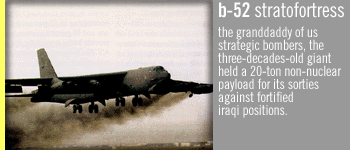



 The development of Boeing's B-52 Stratofortress began in the late 1940s when
the Air Force saw a need for an all-jet bomber that could carry nuclear and
conventional bombs more than 4,000 miles. The B-52 made its first flight in
1952 and entered service with the U.S. Air Force's Strategic Air Command (SAC)
in 1954.
The development of Boeing's B-52 Stratofortress began in the late 1940s when
the Air Force saw a need for an all-jet bomber that could carry nuclear and
conventional bombs more than 4,000 miles. The B-52 made its first flight in
1952 and entered service with the U.S. Air Force's Strategic Air Command (SAC)
in 1954.
Prior to the outbreak of hostilities in the Persian Gulf, B-52s had seen
extensive combat in the Vietnam War. In 1965, SAC B-52s based in Guam and
Thailand began conducting Operation Arc Light carpet bombing raids on Vietcong
strongholds in South Vietnam. In 1972, SAC B-52s began an 11-day series of strategic bombing missions against Hanoi, an action that paved the way for a cease-fire in the war.


Known as the Big Ugly Fat Fellow (BUFF), the B-52 can carry up to 60,000
pounds of bombs, or a mixutre of bombs and air-launched cruise missiles (ALCM)
in internal bays and on underwing pylons. A remote-control tail turret is
armed with either four .50 caliber machine guns or, a 20 millimeter multibarrel cannon for air defense. Advanced electronic systems and terrain-avoidance radar allow for low-level, long-range penetration missions under adverse weather conditions.
The variants presently in U.S. Air Force service are the B-52G and B-52-H.
The B-52H has a wingspan of 185 feet, and is 161 feet long and 41 feet high.
Maximum take-off weight is 488,000 pounds. The B-52H is powered by eight
Pratt and Whitney TF33-P-3 turbofan engines, each delivering its 13,750 pounds of thrust. The aircraft can attain a top speed of nearly 600 miles per hours; maximum range is 10,145 miles, and service ceiling is 55,000 feet.
Problems with the B-1 strategic bomber (all 91 B-1s in service have been
grounded due to problems with the engines) have virtually guaranteed the
continued use of the B-52H until the mid 1990s, and probably beyond. In
Operation Desert Storm, B-52s were used to conduct round-the-clock carpet
bombing attacks against Iraqi troop concentrations and defenses. In addition to high-explosive bombs, the B-52s saturated Iraqi positions with anti-personnell and anti-armor bombs.
---From: Gulf War - A Comprehensive Guide to People, Places & Weapons by
Col. Walter J. Boyne, U.S. A.F. (RET) Signet, 1991


"White Paper--Air Force Performance in Desert Storm" Department of the Air
Force April 1991

home · oral history · war stories · weapons · maps · chronology
tapes & transcripts
FRONTLINE · wgbh · pbs online
web site copyright WGBH educational foundation
 |  |